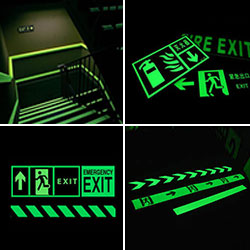









Creating accessible and navigable public spaces is a key priority for architects, contractors, and facility managers in Canada. For individuals with visual disabilities, navigating unfamiliar environments poses numerous challenges. Photoluminescent wayfinding offers an effective solution to enhance accessibility and safety.
As per Canadian codes and standards like the National Building Code of Canada (NBC) and UL 1994, photoluminescent wayfinding systems are mandated in many public buildings and spaces. When thoughtfully designed and installed, these self-illuminating systems provide visual guidance similar to exit signs, even in dark conditions.
This article explores the key factors contractors, architects, and building owners must consider when specifying photoluminescent wayfinding solutions in Canada.
Photoluminescent wayfinding uses glow-in-the-dark signs, strips, and markers to delineate paths of travel within buildings and public spaces. It guides occupants to key areas and amenities even in dark conditions.
Photoluminescent wayfinding relies on special phosphor materials that absorb, store, and emit light. These materials charge themselves using any ambient light source and then illuminate in low-light conditions without electricity.
Strategically placed photoluminescent wayfinding indicators outline safe exit routes, mark stair edges, identify amenities, and provide directional cues that enhance accessibility for those with visual disabilities.
When integrating photoluminescent wayfinding, consider:
Photoluminescent products must comply with various Canadian codes and standards like the NBC, AODA, OBC, NFPA, UL 1994, and provincial codes. Compliance ensures legal conformity and proper performance.
Determine appropriate locations for wayfinding indicators like paths of travel, stairwells, amenities, direction changes, obstructions, etc., based on standards.
Follow specified size criteria for indicatory, like minimum widths for pathway strips, minimum sign heights relative to viewing distance, etc., as per codes.
Ensure proper installation into substrates as per manufacturer instructions using recommended adhesives, anchors, mounts, etc.
Select optimal wayfinding materials and colors to provide sufficient visual contrast against surroundings for high visibility in both light and dark conditions.
Choose durable, long-lasting photoluminescent materials that withstand high-traffic weather and meet all performance specifications.
7. Maintenance
Follow maintenance schedules like cleaning routines and damage inspections to ensure photoluminescent indicators retain visibility and glow intensity.
Investing in compliant photoluminescent wayfinding offers key upsides:
Photoluminescent wayfinding uses various standardized indicators to facilitate navigation:
By incorporating compliant photoluminescent wayfinding elements, public spaces can be made safer and more accessible for the visually impaired.
Various Canadian regulations mandate compliant photoluminescent wayfinding solutions:
Other relevant provincial building codes may also apply based on location. Following applicable standards ensures optimal wayfinding performance and legal conformity.
Tactile Solutions Canada offers a selection of compliant photoluminescent wayfinding solutions like step edge nosing and running man exit signs from trusted manufacturers like Ecoglo to enhance accessibility. Our offerings are:
We provide end-to-end support, from product selection and recommendations to post-installation guidance. Contact Tactile Solution Canada today to make your next public project more accessible with energy-efficient, code-compliant photoluminescent wayfinding solutions.
Common indicators include directional signs, stair edge demarcations, door frame outlines, informational signage, and hazard object markings.
They are mandated in public buildings like transit hubs, offices, malls, healthcare facilities, etc., as per various provincial and national building codes.
It provides clear visual guidance in low-light conditions to enable safe navigation for those who have vision disabilities.
With 1 hour of LED ambient light charging, photoluminescent signs and markers will emit over 70 hours of visibility.
Occasional cleaning every few months, damage inspections, glow testing, and light source access maintenance are advised.
